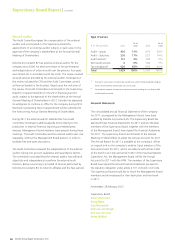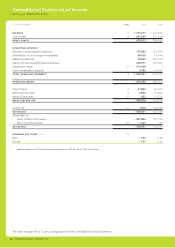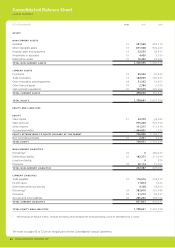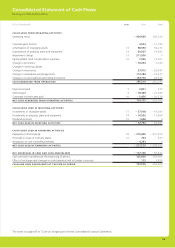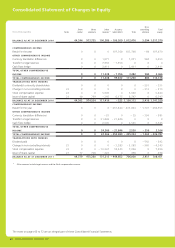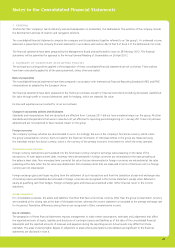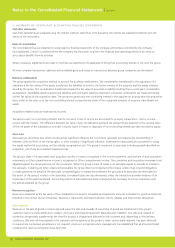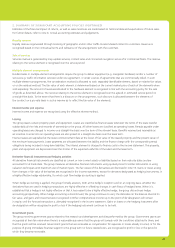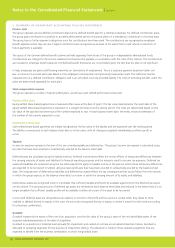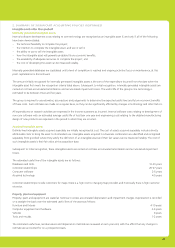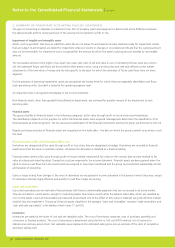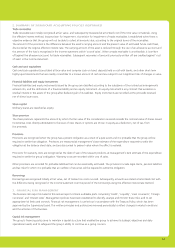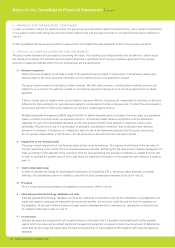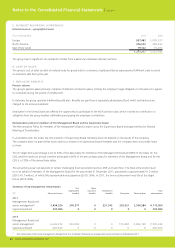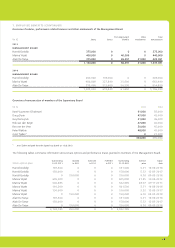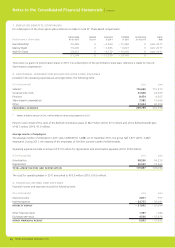TomTom 2011 Annual Report Download - page 49
Download and view the complete annual report
Please find page 49 of the 2011 TomTom annual report below. You can navigate through the pages in the report by either clicking on the pages listed below, or by using the keyword search tool below to find specific information within the annual report.
47
2. SUMMARY OF SIGNIFICANT ACCOUNTING POLICIES (CONTINUED)
Estimates of the fi nancial impact of returns, as well as sales incentives are made based on historical data and expectations of future sales.
For further details, refer to note 4, Critical accounting estimates and judgements.
Royalty revenue
Royalty revenue is generated through licensing of geographic and/or other traffi c-/location-based content to customers. Revenue is
recognised based on the contractual terms and substance of the arrangements with the customers.
Sale of services
Services revenue is generated by map update services, content sales and connected navigation services for commercial fl eets. The revenue
relating to the service element is recognised over the service period.
Multiple element arrangements
Bundled sales or multiple-element arrangements require the group to deliver equipment (e.g. navigation hardware) and/or a number of
services (e.g. traffi c information services) under one agreement, or under a series of agreements that are commercially linked. In such
multiple-element arrangements, the consideration received is allocated to each separately identifi able element, based on relative fair values
or on the residual method. The fair value of each element is determined based on the current market price of each of the elements when
sold separately. The amount of revenues allocated to the hardware element is recognised in line with the accounting policy for the sale
of goods as described above. The revenue relating to the service element is recognised over the agreed or estimated service period on
a straight-line basis. To the extent that there is a discount on the arrangement, such discount is allocated between the elements of
the contract on a pro rata basis in such a manner as to refl ect the fair value of the elements.
Interest income and expense
Interest income and expense are recognised using the effective interest method.
Leasing
The group leases certain property, plant and equipment. Leases are classifi ed as fi nance leases whenever the terms of the lease transfer
substantially all the risks and rewards of ownership to the group. All other leases are classifi ed as operating leases. Rentals payable under
operating leases are charged to income on a straight-line basis over the term of the relevant lease. Benefi ts received and receivable as
an incentive to enter into an operating lease are also spread on a straight-line basis over the lease term.
Finance leases are capitalised at the lease commencement date at the lower of fair value of the leased property and the present value of
the minimum lease payments. Lease payments are allocated between the liability and the fi nance charge with the corresponding rental
obligations being included in long-term liabilities. The interest element is charged to fi nance costs in the income statement. The property,
plant and equipment are depreciated over the shorter of the expected useful life of the asset and the lease term.
Derivative fi nancial instruments and hedging activities
All derivative fi nancial instruments are classifi ed as current or non-current assets or liabilities based on their maturity dates and are
accounted for at trade date. The group measures all derivative fi nancial instruments using quoted prices for similar instruments or using
valuation techniques with maximum use of market inputs. The fair values of the derivatives are disclosed in note 19. Gains or losses arising
from changes in fair value of derivatives are recognised in the income statement, except for derivates designated as hedging instruments, in
a highly effective hedge relationship, for which cash fl ow hedge accounting is applied.
When hedge accounting is applied, the group formally assesses, both at the hedge’s inception and on an ongoing basis, whether the
derivatives that are used in hedging transactions are highly effective in offsetting changes in cash fl ows of hedged items. When it is
established that a hedge is not highly effective or that it has ceased to be a highly effective hedge, the group discontinues hedge
accounting prospectively. When hedge accounting is discontinued, the group continues to carry the derivative on the balance sheet at its
fair value, and gains and losses that were recognised in Other comprehensive income up to the point of de-designation will remain
in equity until the forecast transaction is ultimately recognised in the income statement. Gains or losses on the hedging instrument after
de-designation will be recognised in profi t or loss if the hedging instrument continues to be held.
Government grants
The group receives government grants related to the research and development activities performed by the group. Government grants are
recognised at their fair value when there is a reasonable assurance that the group will comply with the conditions attached to them, and
that the grants will be received. Government grants that are receivable as compensation for expenses or losses already incurred, or for the
purpose of giving immediate fi nancial support to the group with no future related costs, are recognised in profi t or loss in the period in
which they become receivable.



